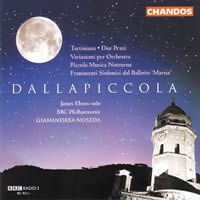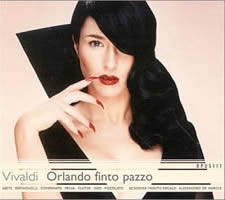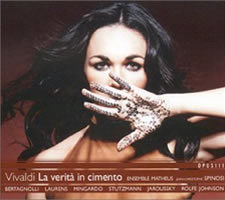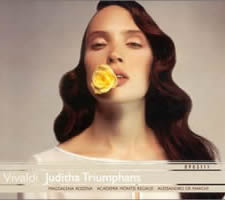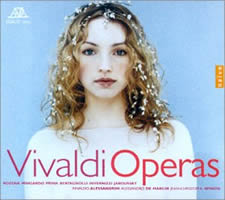Italian Vacation 2.
|
Grant Chu Covell [February 2005.] A year and a half ago, my Italian Vacation 1. received extra Internet hits not because Nono and Sciarrino were suddenly in vogue, but rather that Googlers were seeking travel tips. Apologies to those who arrived here expecting to learn about valpolicella, rentable Palladian villas, or Florentine gelati vendors. I’ll need to win the lottery before I can help you. For now, here are some exciting releases featuring music of Luigi Dallapiccola, Fausto Romitelli and a fellow named Vivaldi.
Luigi DALLAPICCOLA: Tartiniana (1951); Due Pezzi (1947); Piccola Musica Notturna (1954); Frammenti Sinfonici dal Balletto ‘Marsia’ (1942-43, 1947); Variazioni per Orchestra (1953-54). James Ehnes (violin); BBC Philharmonic, Gianandrea Noseda (cond.). Chandos 10258 (http://www.chandos.net/). Chandos delivers a stellar, single-disc introduction to Dallapiccola, Italy’s first confident serialist. (Apparently Scelsi was the first to dabble with the 12-tone method, but, understandably, it didn’t suit him.) These pieces don’t suggest Schoenberg’s pointy elbows or next-generation Nono’s asceticism. Dallapiccola miraculously blended Puccini’s lyricism with Webern’s structural rigor. Yes, he really did. Derived from a fellow Istrian’s tunes, the relaxed Tartiniana weds a lone violin to a violinless orchestra. James Ehnes is the effervescent soloist in this humble neo-classical (or neo-baroque) concerto which leans towards Webern’s Bach rather than Stravinsky’s. Canons — a Dallapiccola fingerprint — are buried everywhere, as in the third movement where the trombone follows the bass clarinet and later on in the same movement’s middle section which reverses back upon itself. In two movements, Due Pezzi orchestrates the violin-and-piano Due Studi. A delicately lugubrious sarabande suggesting a serial Ravel precedes a defiant fanfare with fugue. The Marsia fragments are the earliest Dallapiccola here. Imagine Respighi except with muscle and music. The myth of Marsyas and Apollo, a martyred satyr challenging a greater force, symbolizes Dallapiccola’s anti-Fascist stance. Probably the briefest representation of Dallapiccola’s art, Piccola Musica Notturna is a supremely elusive trifle, composed in seven days at Hermann Scherchen’s request. Forte bolts shatter this “little night music’s” false tranquility. The Variazioni is an orchestration of Dallapiccola’s piano opus, Quaderno Musicale di Annalibera. Written for the Louisville Symphony Orchestra (First Edition Music FECD-0001 reissues the premiere recording), this transcription of 11 serial canons and short studies sounds tailor-made for orchestra. Dallapiccola’s scores are minutely detailed: Few notes are without dynamic or expressive markings. The BBC Philharmonic under Gianandrea Noseda captures every indication, playing lushly, responding to the music’s energy. Ehnes shines in Tartiniana. These recordings set definitive standards for these deserving works. Chandos has done well. Good Dallapiccola is scarce. Sony SK 68323 offers perhaps Dallapiccola’s most important work, the brief opera Il Prigioniero (1944-48). Esa-Pekka Salonen leads Phyllis Bryn-Julson and others with the Swedish Radio Symphony Orchestra, also including the three Canti di prigionia (1938). Piccola Musica Notturna opens “Wien Modern III” with Claudio Abbado and the Gustav Mahler Jugendorchester (DG 447 115-2). A relatively recent Naïve V 4960 (2 CDs) captures Ulisse’s May 6, 1975 performance under Ernest Bour. A listener’s patience may well wear thin across the opera’s two weighty acts. Of Quaderno Musicale di Annalibera recordings, Ruggero Ruocco’s is admirable for its precision (AS disc AS 5006).
“Professor Bad Trip.” Fausto ROMITELLI: Professor Bad Trip (1998-2000); Seascape (1994); Green, Yellow and Blue (2002); Trash TV Trance (2002). François Deppe (transformed cello), Tom Pauwels (electric guitar), Antonio Politano (contrabass recorder); Ictus, Georges-Elie Octors (cond.). Cyprès CYP5620 (http://www.cypres-records.com/). Romitelli mashes traditional instruments with rock-informed electric guitars and electronics, concocting a wonderful paste. This is nothing like Bang on a Can’s smug gimmickry or Icebreaker’s grungy rep. Think of the humor and style of the “Boulez Conducts Zappa” collaboration (Barking Pumpkin Records D2 74242) but add amplification and teeth. Romitelli studied at IRCAM with Gérard Grisey and Tristan Murail. Dead at 41, his loss is notable because he had a darn good ear and created fine music. This disc is essential: Stop reading and get it now. Inspired by Henri Michaux’s writings and mescaline experiences, Professor Bad Trip takes the form of three lessons. Jonathan Harvey’s ironic milquetoast voice introduces each. The lessons intersperse chaos with breathing room. Frenzied string glissandi and Messiaen-like figurations may slam to a sudden stop, exposing a raunchily munged solo cello. Lesson One closes with a lusciously cool electronic finale. Lesson Two reveals an eerily transformed cello. Slithery and acrobatic like its predecessors, Lesson Three plays memory tricks through repetition and recycling. The Professor’s deformed world is absorbing. Seascape for amplified contrabass Paetzold recorder writhes like a feral Loch Ness monster. Subtle harmonics and multiphonics are recorded up close, expertly amplified and let out to rip. The Trapp family would not approve. Brash and invigorating, Green, Yellow and Blue bounds like traffic quickly zipping through a dangerous intersection. A grisly crash feels imminent. For 16 players, it’s the most synthetic-sounding work (all these pieces list their sound engineers, editors and mixers) and the most obviously connected to the 20th-century chamber-ensemble tradition: Schoenberg and Ligeti are not far behind. The disc’s last, Trash TV Trance, a 12-minute nose-thumbing riff for electric guitar, hovers gleefully between grunge and ivory tower. Punched with reverb and noise, and using only the barest suggestion of bluesy phrases, this is the electric guitar piece every contemporary composer wants to write (nods to Hendrix and Dick Dale). Rich glissandi and amplified tweets suggest analogue sound’s glory days, yet the effects processing, controlled volume and sudden cut-offs could only happen today. The Ictus team is phenomenal, and Cyprès’ digipak and modern typography add an extra layer to the rewarding experience. Find a French-only essay on Romitelli here. This is a supremely well-made concoction, easily one of this year’s best. I’ve raved about their Aperghis, Harada and Harvey discs, and I’m doubly determined to grab any Cyprès / Ictus combination. Ictus has been playing Romitelli’s final work, An Index of Metals (2003), a video opera for soprano, ensemble, multi-projections and electronics, in France during January 2005. Romitelli’s legacy is in good hands.
Never mind that Naïve dresses its Vivaldi series (on the Opus 111 line; dist. in the US by Naxos [http://www.naxos.com/]) in Benetton-inspired covers plastered with awkwardly posed, scantily clad models. The discs themselves contain sparkling ensembles and luscious singing. There is more to the red-haired priest than his seemingly inexhaustible fund of concertos. Until these releases, I based my Vivaldi fetish upon his superficial resemblance to minimalism. Vivaldi as First Minimalist is hardly an original idea: strong rhythms over sequencing chord patterns, melodies centering on triadic pitches, and a recognizable vocabulary of cadences and gestures. However, there’s nothing minimal here. Naïve’s series thrives at a higher plateau. Vivaldi’s oratorios and operas buzz with drama, sensitive coloring and captivating tunes, to say nothing of these dedicated and superb performances. Orlando finto pazzo (1714), RV 727, spans three discs (Naïve OP 30392). Alessandro De Marchi directs the Academia Montis Regis and the Coro del Teatro Regio di Torino. Orlando was Vivaldi’s first opera for the Venetian stage, a powerful salvo meant to marry tradition with innovation. He would make or break his reputation with this one. (He made it.) The funny-sounding title means “Orlando feigns madness.” When the main character pretends to be crazy, or when the evil sorceress Ersilla appears, Vivaldi exploits delicious effects: arias accompanied by three viola lines, raspy sul ponticello, and whirring harpsichord arpeggios supporting recitatives. A handful of alternative arias complete the third disc. This is the first recording I’ve seen which diagrams the characters’ love interests. A plot sample:
Jean-Christophe Spinosi leads Ensemble Matheus in La verità in cimento (1720), RV 739 (Naïve OP 30365). Closely recorded contrabass and cellos deliver a visceral snap to the opening three-movement sinfonia’s accented notes. Throughout, a varied continuo draws upon harpsichord, guitar, and theorbo. As a pianist may interpret Chopin’s rubato, Spinosi frequently indulges in slightly erratic beats which work expressive wonders. The initial ten seconds will tell whether you’re in or out. Ensemble Matheus sustains energy across the evenly paced dramatic action which reserves brass until the third act. A memorable second-act aria, “Vinta à piè d’un dolce affetto,” indulges in slithery minor-mode chromatics. Juditha triumphans devicta Holofernis barbarie (1716), RV 644 (Naïve OP 30314), opens with a delectable two-movement sinfonia (RV 562) especially reconstructed for this production, before settling into the grisly story of Judith beheading Holofernes. Women perform all roles in this Latinate oratorio. De Marchi’s Academia Montis Regalis plays crisply and with unbridled energy. Magdalena Kožena is a silky and seductive Judith as in “Quanto magis generosa.” Kožena also sings “Veni, veni, me sequere fida,” Juditha triumphans’ most exquisite aria, backed with exquisitely sweet chalumeau, the clarinet’s ancestor. Other memorable numbers include the spooky chorus which closes the first part, “Mundi Rector de Caelo micanti,” and another of Judith’s arias, “Transit aetas,” with mandolin. Detailed notes reflect De Marchi’s dedication. Juditha triumphans is an excellent starting block. Orlando finto pazzo and La verità in cimento are serious and satisfying investments. If you’re tempted, you must score the single-disc “Vivaldi Operas” sampler (Naïve OP 30401) providing choice cuts from Juditha triumphans, Orlando finto pazzo, La verità in cimento and another opera, L’Olimpiade. Hear Spinosi alternate between grit and sunshine in “Se l’acquisto di quel Soglio” from La verità in cimento and the red priest’s nutty effects for Orlando finto pazzo. You also get Juditha triumphans’ “Veni, veni, me sequere fida,” which alone is worth the price of the disc.
[More Grant Chu Covell, Italian Vacation]
[Previous Article:
The Forgotten, the Unfamiliar and the Unknowable]
[Next Article:
On Themes by Klimt and Mahler]
|
